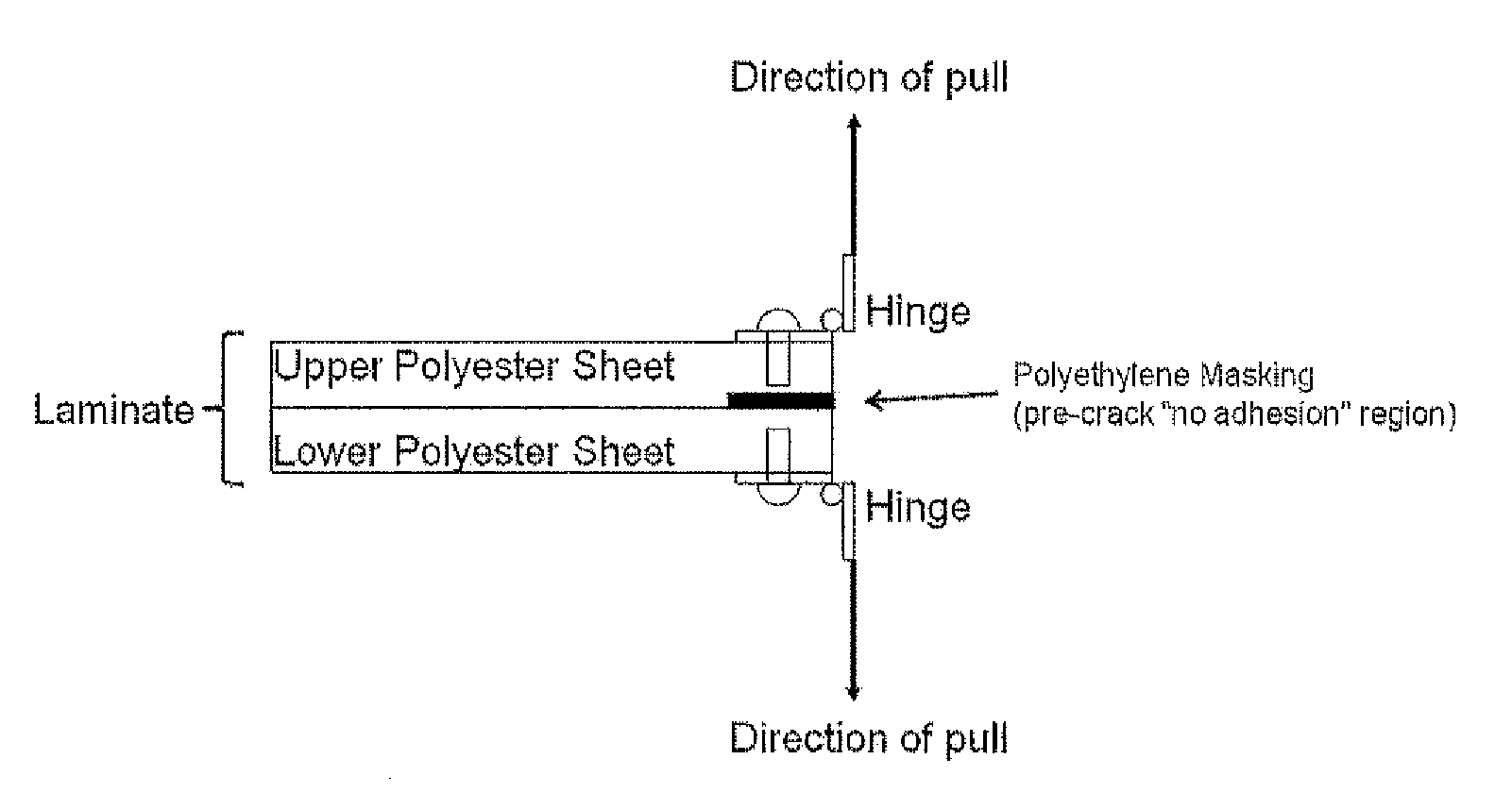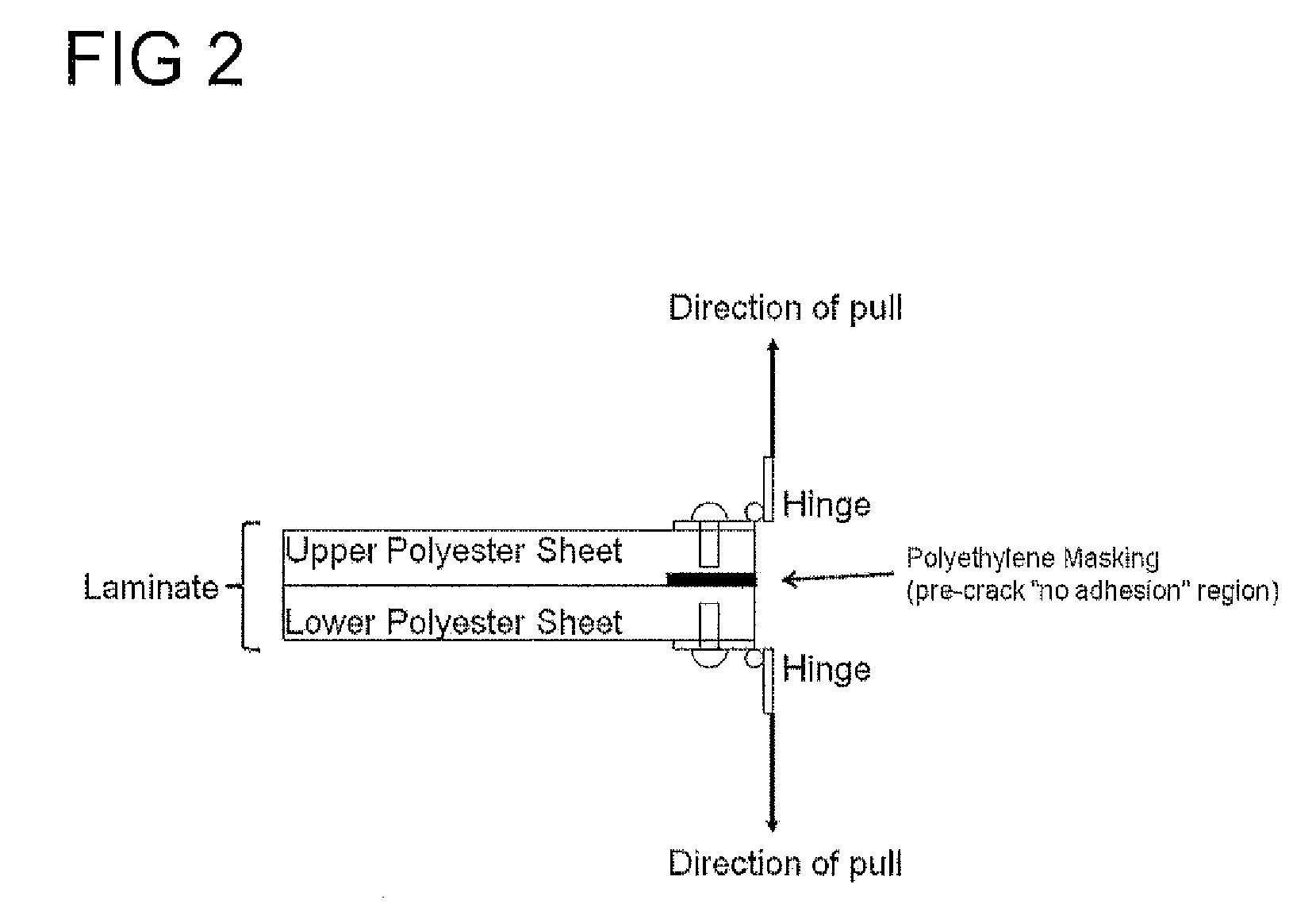Lamination process optimization utilizing neopentyl glycol-modified polyesters
a technology of neopentyl glycol and polyester, which is applied in the field of lamination process optimization of neopentyl glycol-modified polyesters, can solve problems such as inclusion fracture, aesthetic defects of yielding panels, and undesirable distortion
- Summary
- Abstract
- Description
- Claims
- Application Information
AI Technical Summary
Problems solved by technology
Method used
Image
Examples
example 1
[0047]Extruded sheet samples of 0.118 inch thickness were made from Radici's Radicron 1480 (NPG-modified polyester, now available from Artenius, a division of La Seda de Barcelona under the Radicron brand name) by drying the resin at about 160 deg F. overnight then feeding the resin to an extruder—a non-vented MPM extrusion line with a L / D of 25:1 fitted with a 2.5 inch barrier-type screw. The extrusion conditions included a straight profile temperature set point of about 490 deg F. which resulted in a production rate of approximately 100 pounds per hour. The materials were extruded through a 20 inch coat hanger die onto a 3 roll stack configuration. The roll temperatures were set to cool the sheet while minimizing stress with cooling temperature set points of 80 deg F. on the top roll, 120 deg F. on the middle roll and 150 deg F. on the bottom roll.
example 2
[0048]Extruded sheet samples of 0.118 inch thickness were made from Spectar 14471(CHDM-modified polyester) by drying the resin at about 160 deg F. overnight then feeding the resin to an extruder—a non-vented MPM extrusion line with a L / D of 25:1 fitted with a 2.5 inch barrier-type screw. The extrusion conditions included a straight profile temperature set point of about 490 deg F. which resulted in a production rate of approximately 100 pounds per hour. The materials were extruded through a 20 inch coat hanger die onto a 3 roll stack configuration. The roll temperatures were set to cool the sheet while minimizing stress with cooling temperature set points of 80 deg F. on the top roll, 120 deg F. on the middle roll and 150 deg F. on the bottom roll. The extruded sheet from Examples 1 and 2 were then analyzed with the following results:
TABLE 1Analytical Test Results for Polyester SamplesChemical Composition (NMR)Glass TransitionInherentMolecular WeightTPAEGCHDMNPGDEGTemperature (DSC)V...
examples 3-13
[0053]The samples described in Examples 1 and 2 were then subjected to extended heat histories in a thermocompressive lamination process to discover the relationship between adhesive strength versus lamination time for each category of materials. A 12 inch square layup was assembled according to the following layered arrangement—a layer of blotter paper on bottom, a 60 mil rubber pad, a polished metal caul sheet, Sappi release paper with a “patent” high gloss finish, 0.118 inch extruded sheet sample, a second 0.118 inch extruded sheet sample (to form a laminate) and continuing this layup pattern in reverse (release paper, caul sheet, rubber pad, blotter paper). It should be also be noted that a 0.001 inch×1 inch×12 inch strip of polyethylene masking was inserted between the two extruded sheet samples along one edge to prevent lamination in this localized area. This “pre-crack” aids in proper adhesion measurement. J-type thermocouple wires were also inserted between the two extruded ...
PUM
| Property | Measurement | Unit |
|---|---|---|
| inherent viscosity | aaaaa | aaaaa |
| thickness | aaaaa | aaaaa |
| thickness | aaaaa | aaaaa |
Abstract
Description
Claims
Application Information
 Login to View More
Login to View More - R&D
- Intellectual Property
- Life Sciences
- Materials
- Tech Scout
- Unparalleled Data Quality
- Higher Quality Content
- 60% Fewer Hallucinations
Browse by: Latest US Patents, China's latest patents, Technical Efficacy Thesaurus, Application Domain, Technology Topic, Popular Technical Reports.
© 2025 PatSnap. All rights reserved.Legal|Privacy policy|Modern Slavery Act Transparency Statement|Sitemap|About US| Contact US: help@patsnap.com



